In this world, there’s plenty of logical abilities every creature has to survive. From running away from predators to seeing prey, some abilities just make sense. But, then there are the underwater creatures who have abilities that defy reason. They’re so ludicrous it’s hard to understand how they were able to obtain them in the first place. Curious to hear what crazy abilities these underwater creatures have? Here are 25 Incredible Underwater Creatures With Abilities That Defy Logic.

Dolphins
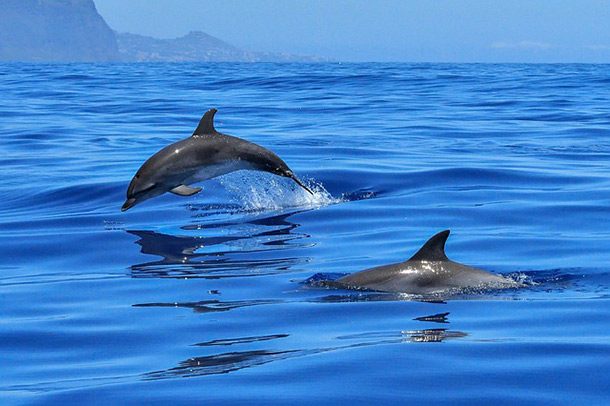 Source: https://www.scientificamerican.com/article/how-do-whales-and-dolphin/
Source: https://www.scientificamerican.com/article/how-do-whales-and-dolphin/ Ever wonder how dolphins can sleep while underwater? Well, they have the bizarre ability to turn off half their brain while the other half stays alert for predators and can swim up to the surface of the water for air. They call this process “cat-napping.”
Humpback Whales
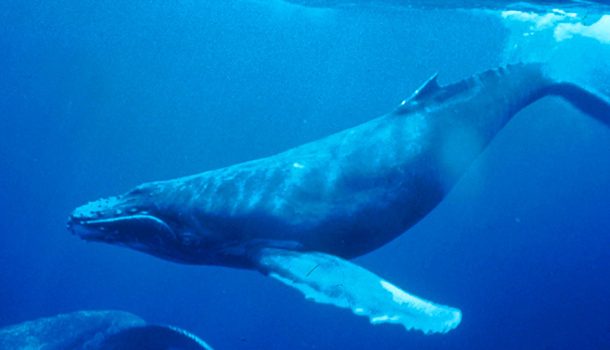 Source: https://www.sciencedaily.com/releases/2011/06/110624083516.htm
Source: https://www.sciencedaily.com/releases/2011/06/110624083516.htm Humpback whales are massive creatures of the sea, measuring up to 14 meters long. To feed, they perform complex swimming maneuvers while creating wide bubble nets to lure and capture their prey. It’s their most effective way to feed on the tiny plankton and krill.
Starfish
 Source: https://www.nationalgeographic.com/animals/invertebrates/group/starfish/
Source: https://www.nationalgeographic.com/animals/invertebrates/group/starfish/ Starfish (or more appropriately called Sea Stars because let’s face it, they aren’t even fish) have two especially freaky abilities. First, they’re capable of regenerating limbs and in some cases their entire body from a limb. They also can feed on prey outside their body. Using suction-cupped tube feet, they can pry open clam shells and devour them by oozing their stomach into the shell.
Octopus
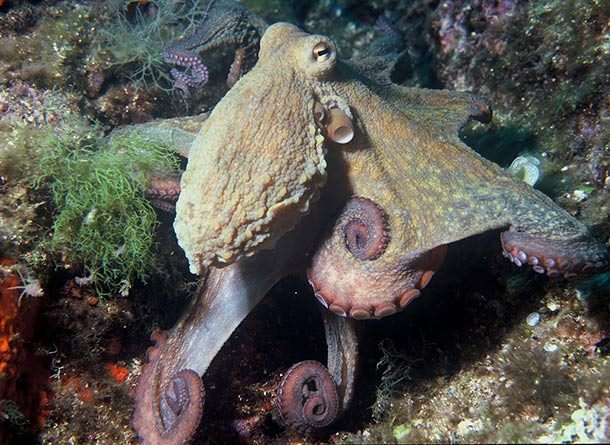 Source: http://www.animalfactguide.com/animal-facts/common-octopus/
Source: http://www.animalfactguide.com/animal-facts/common-octopus/ The octopus is a pretty strange looking creature, but it also has some bizarre abilities. As a defense mechanism, it releases purple-black ink before propelling itself through the water at speeds up to 25 miles per hour (40 kph). It can also change colors that indicate what it’s feeling, like fear or anger.
Sea Cucumbers
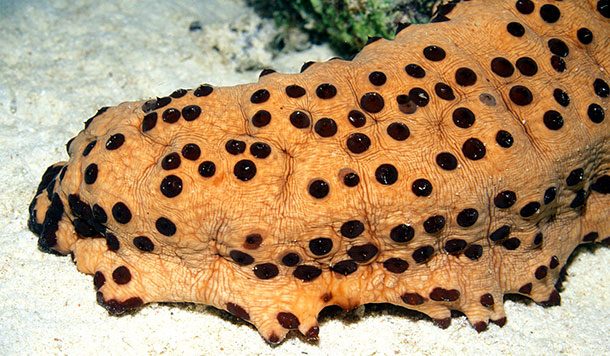 Source: https://www.aol.com/article/news/2016/10/17/this-sea-creature-will-surprise-you-with-this-weird-feature/21584419/
Source: https://www.aol.com/article/news/2016/10/17/this-sea-creature-will-surprise-you-with-this-weird-feature/21584419/ Sea Cucumbers may have no brains, but that doesn’t mean they’re defenseless. In a truly bizarre and disgusting defense tactic, the sea cucumber can shoot its intestines out of itself at whatever is attacking them. This process is called evisceration.
Hagfish
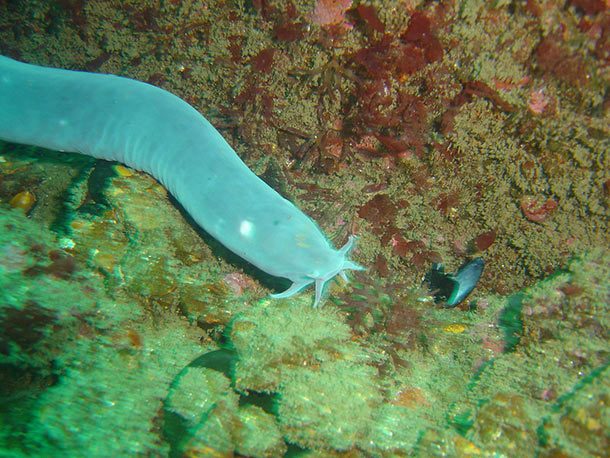 Source: https://www.smithsonianmag.com/science-nature/14-fun-facts-about-hagfish-77165589/
Source: https://www.smithsonianmag.com/science-nature/14-fun-facts-about-hagfish-77165589/ Sometimes called “Slime Eels,” Hagfish are quite gifted with weird abilities. From absorbing nutrients through their skin to going months without food, these creatures almost seem like they’re from another world. To fight off predators and keep other creatures away from its prey, they secrete slime which once it hits water becomes a transparent sticky substance. Some think it could fill a five-gallon bucket.
Chitons
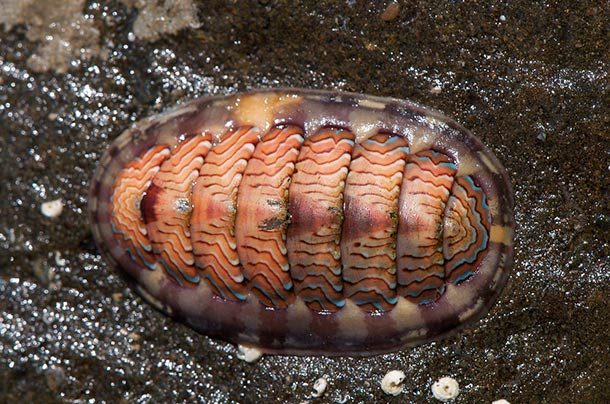 Source: http://phenomena.nationalgeographic.com/2011/04/14/chitons-see-with-eyes-made-of-rock/
Source: http://phenomena.nationalgeographic.com/2011/04/14/chitons-see-with-eyes-made-of-rock/ Chitons are armored mollusks that crawls around on the ocean floor using a powerful leg. However, the most insane part of the Chiton is its eyesight. Unique among all living creatures, a Chiton’s eyes are made of limestone. That’s right; its eyes are rocks! They’re called ocelli. They cover the Chitons body and erode as it gets older.
Platypus
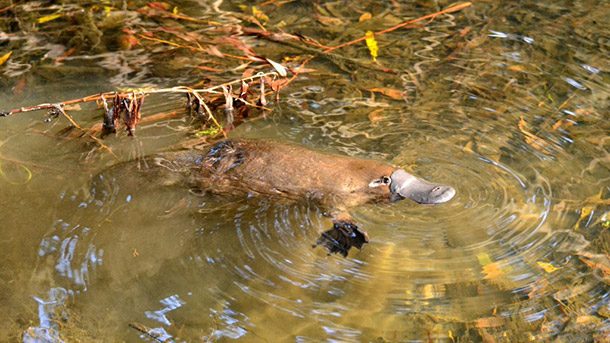 Source: http://mentalfloss.com/article/63062/10-curious-and-quirky-platypus-facts
Source: http://mentalfloss.com/article/63062/10-curious-and-quirky-platypus-facts Everyone knows the platypus is a total freakshow. But, not many know how strange these duck-beavers-looking animals are. For instance, did you know they don’t have stomachs? What about the fact that the mothers don’t have nipples and milk their young by sweating it on their bellies? Or that it uses gravel to mush up its prey? It’s bill also has an incredible ability to sense the electric field generated by all living things, allowing it to hunt without eyes, ears, or any of its other senses.
Crocodile
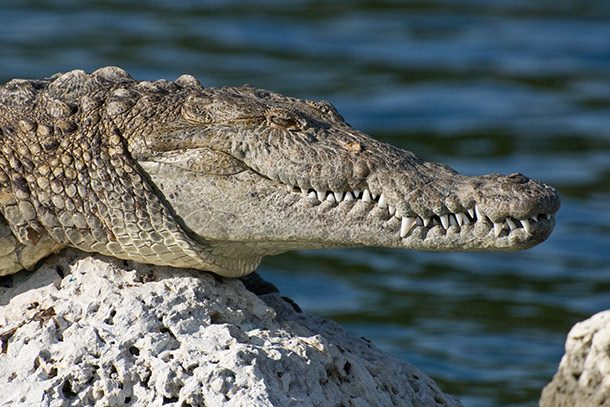 Source: http://animals.mom.me/crocodiles-swallow-stones-2513.html
Source: http://animals.mom.me/crocodiles-swallow-stones-2513.html Crocodiles are terrifying creatures most people want to stay away from at all times. Besides lurking in the shallows, waiting for its prey, crocodiles have one very bizarre ability to eat large stones. Why in the world would they do this? Well, it helps with their digestion. Called “Gastroliths,” the rocks help grind and crush the food in its stomach; the stones can also remain in their stomachs for years.
Sperm Whales
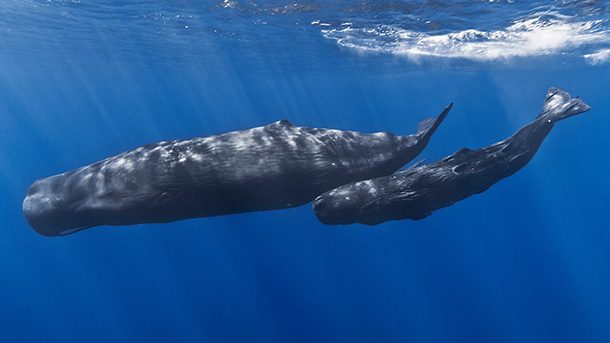 Source: http://www.seasky.org/deep-sea/sperm-whale.html
Source: http://www.seasky.org/deep-sea/sperm-whale.html Growing up to 67 feet (20 meters), sperm whales are massive mammals living, swimming, and hunting in every ocean on Earth. Unlike humans and other mammals that can only survive at certain depths of water, sperm whales have the unique ability to dive to incredible depths of 10,000 feet (3,048 meters). They’re considered the deepest sea mammals in the world and can stay underwater for up to 2 hours before coming up for air.
Pistol Shrimp
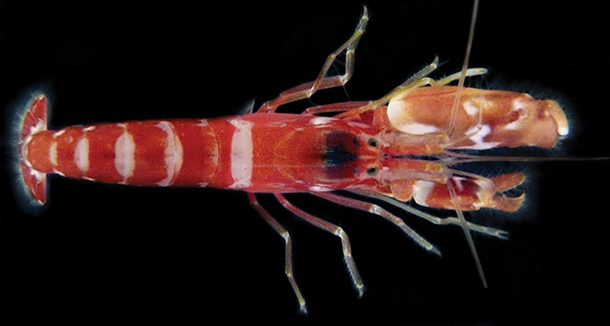 Source: https://www.wired.com/2014/07/absurd-creature-of-the-week-pistol-shrimp/
Source: https://www.wired.com/2014/07/absurd-creature-of-the-week-pistol-shrimp/ The Pistol Shrimp has an ability pretty much every species on the planet can only dream of having, and if a human had it, would make them an X-Men. They have an enormous claw they use to fire fast flying bubbles at their enemies, knocking them out or potentially killing them cold. The sound reaches 210 decibels, louder than an actual gunshot. Once it snipes its prey, it drags it into its cave to be consumed.
Polar Fish
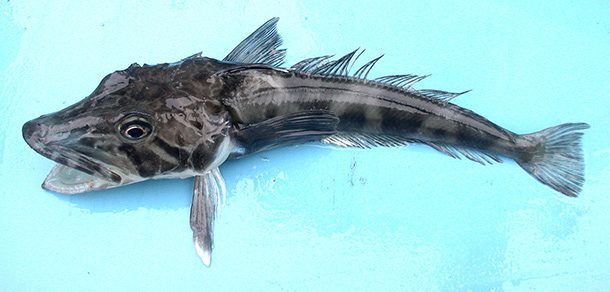 Source: https://www.wired.com/2010/08/arctic-fish-antifreeze/
Source: https://www.wired.com/2010/08/arctic-fish-antifreeze/ Ever wonder how fish don’t freeze to death in the Arctic Ocean? The Arctic keeps a consistent 28 degrees Fahrenheit year-round while the freezing point of fish blood is 30 degrees. At some point, they’d freeze, right? Turns out, these fish have a protein in their blood that acts as a kind of antifreeze, protecting them from freezing. And, believe it or not, it works even better than the antifreeze in your car.
Cuttlefish
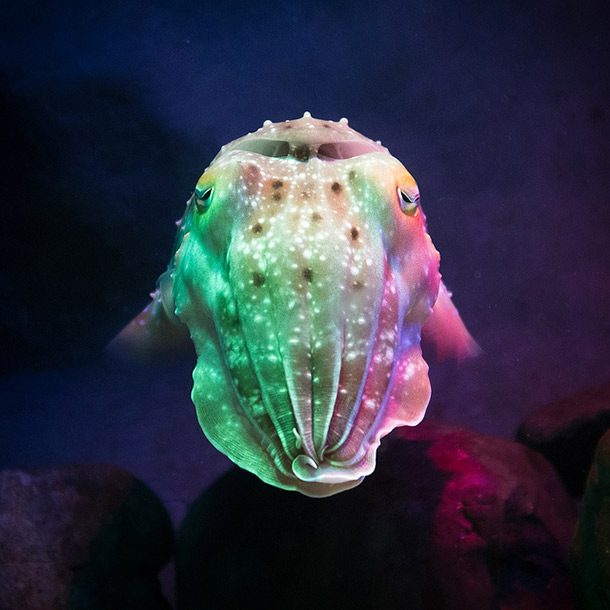 Source: http://www.isciencetimes.com/articles/6758/20140129/cuttlefish-change-color-chameleon-sea-military-camouflage.htm
Source: http://www.isciencetimes.com/articles/6758/20140129/cuttlefish-change-color-chameleon-sea-military-camouflage.htm Cuttlefish are pretty remarkable. By using pigmented organs on their skin called chromatophores, they can change their skin into any color or pattern, mimicking the world around them. They can also use the colors like a strobe light, mesmerizing their prey. They also have one of the largest brain-to-body ratios among mammals, helping it control the 20 million chromatophores.
Black Swallower
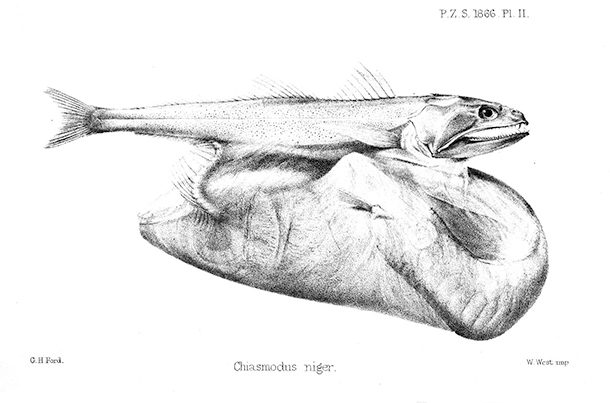 Source: http://www.discovery.com/dscovrd/wildlife/meet-the-black-swallower-a-nightmarish-binge-eater/
Source: http://www.discovery.com/dscovrd/wildlife/meet-the-black-swallower-a-nightmarish-binge-eater/ Living 10,000 feet below sea level, the 10 inch long Black Swallower doesn’t have many food sources to choose from. So, in order to survive, it has to improvise and eat something twice or three times its size. However, it’s been know to bite off more than it can chew, causing the large fish in its stomach to burst through it.
Hippopotamus
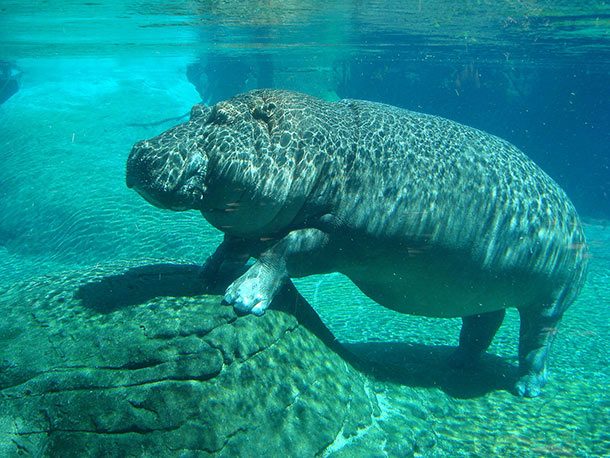 Source: https://www.livescience.com/27339-hippos.html, https://animals.howstuffworks.com/mammals/hippo-sunscreen.htm
Source: https://www.livescience.com/27339-hippos.html, https://animals.howstuffworks.com/mammals/hippo-sunscreen.htm Yes, technically, hippopotamuses are underwater creatures. They spend up to 16 hours underwater during the day and come out at night to hunt. However, sometimes when they come out during the day on dry land, the African sun beats down on them, exposing them to getting sunburns. Fortunately for them, their sweat acts like a type of sunscreen, reflecting the UV rays and keeping them protected.
Sea Slugs
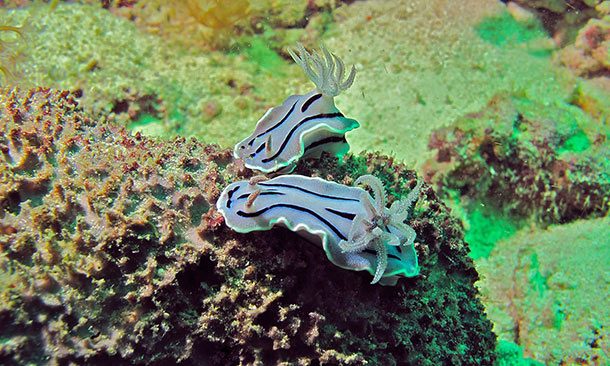 Source: http://www.iflscience.com/plants-and-animals/sea-slug-steals-photosynthesis-genes-its-algae-meal/
Source: http://www.iflscience.com/plants-and-animals/sea-slug-steals-photosynthesis-genes-its-algae-meal/ By all accounts, the green Sea Slug should starve to death based on its diet of algae. Surprisingly, like plants, it can nourish itself through photosynthesis; its actually the algae diet that allows it to do this because its chromosomes have some of the same genes as the algae.
Planarians
 Source: http://mentalfloss.com/article/61665/13-things-you-didnt-know-about-planarians
Source: http://mentalfloss.com/article/61665/13-things-you-didnt-know-about-planarians Planarians are free-living flatworms living around the world in all kinds of environments. They have many unique abilities but one, in particular, is regeneration. While growing back a tail isn’t all that crazy, scientists have discovered a way to cut a planarian in half at a certain point and rather than growing back their tail, it’ll grow another head! They’ve also discovered that if you transplant a planarian brain in another planarian body, it’ll start controlling the body.
Immortal Jellyfish
 Source: https://www.amnh.org/explore/news-blogs/on-exhibit-posts/the-immortal-jellyfish/
Source: https://www.amnh.org/explore/news-blogs/on-exhibit-posts/the-immortal-jellyfish/ Immortal Jellyfish truly live up to their name. Using a process called transdifferentiation, they can morph back into an earlier developmental stage, virtually allowing them to live forever.
Mudskippers
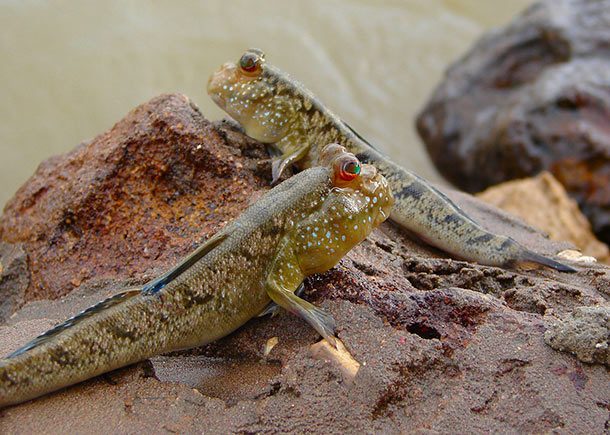 Source: http://www.iflscience.com/plants-and-animals/mudskipper-fish-eat-land-using-their-tongue-made-water/
Source: http://www.iflscience.com/plants-and-animals/mudskipper-fish-eat-land-using-their-tongue-made-water/ Mudskippers maybe don’t defy logic as much as they just can’t make up their minds. They’re fish known to come up on land and return back into the water. However, they don’t have legs, so when they get on land, they mostly flap around to move. To make things even weirder, mudskippers collect a mouthful of water they can use as a tongue to capture their prey.
Teddy Bear Crab
 Source: https://listverse.com/2014/10/18/10-weird-and-wonderful-species-of-true-crabs/
Source: https://listverse.com/2014/10/18/10-weird-and-wonderful-species-of-true-crabs/ At first glance, you might have the urge to hug and pet the Teddy Bear Crab, but we’d advise against it. With their many silky hairs called “setae,” the Teddy Bear Crab blends into the coral around it. These long hairs act as a net to capture particles and dirt and make its disguise even more convincing. Along with their weird hairs, female Teddy Bear Crabs can carry up to 800 eggs at a time.
Archerfish
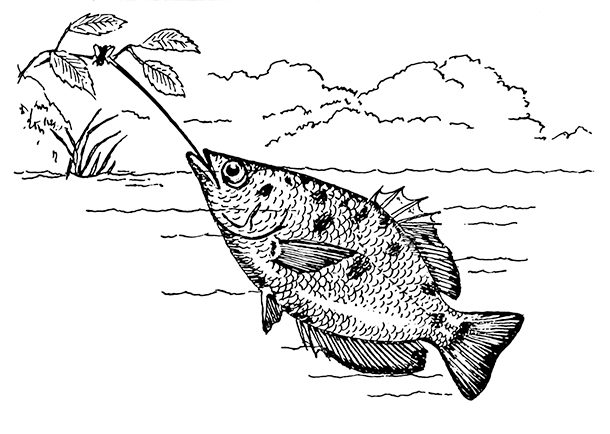 Source: http://www.bbc.com/earth/story/20160223-how-do-fish-shoot-arrows-of-water
Source: http://www.bbc.com/earth/story/20160223-how-do-fish-shoot-arrows-of-water Archerfish have a general problem. With all the insects roaming above the water, how are they supposed to attack and eat them? Well, amazingly, they’ve figured out how to use the water to their advantage. Like snipers from below, they can shoot short or long streams of water out of their mouth, hit their unsuspecting prey, and quickly devour them when they hit the water’s surface.
Pirate Perch
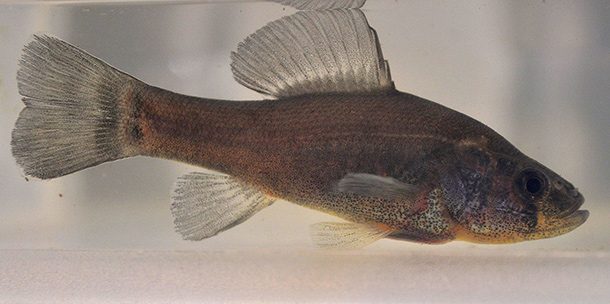 Source: https://www.sciencedaily.com/releases/2013/03/130329085941.htm
Source: https://www.sciencedaily.com/releases/2013/03/130329085941.htm The Pirate Perch is a master at hiding from both predators and prey. Using a chemical from its body, it acts as a camouflage to stay hidden from other watery creatures. Scientists are still unsure how the Pirate Perch is able to do this; they’re not sure if it makes the receiver confused or merely masks the Pirate Perch’s smell.
Goliath Tigerfish
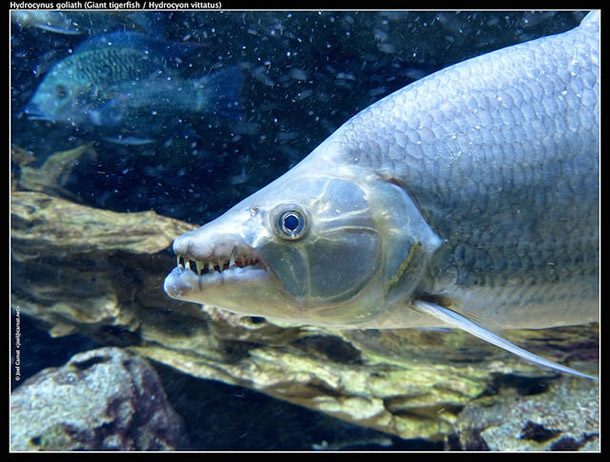 Source: http://www.animalplanet.com/tv-shows/river-monsters/fish-guide/goliath-tigerfish/
Source: http://www.animalplanet.com/tv-shows/river-monsters/fish-guide/goliath-tigerfish/ The Goliath Tigerfish is not something you’d want to keep in your home aquarium. The massive, sharp-toothed fish is so fearsome it isn’t afraid of crocodiles and has even been known to eat them! Despite its terrifying teeth and overall danger, some experts still go out into the Congo River Basin to catch them.
Hairy Frog
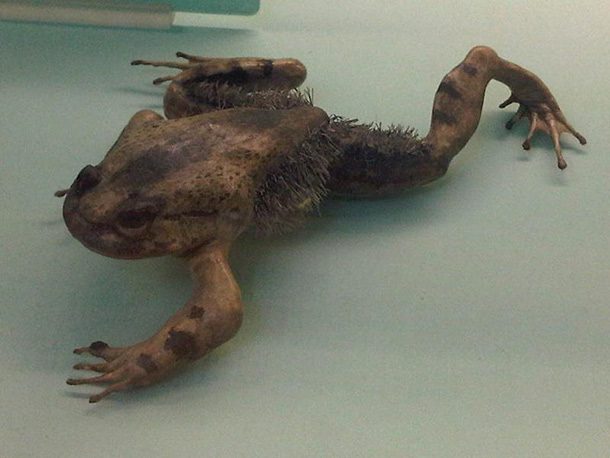 Source: https://blogs.scientificamerican.com/tetrapod-zoology/squeakers-frogs-with-claws-frogs-with-hair/
Source: https://blogs.scientificamerican.com/tetrapod-zoology/squeakers-frogs-with-claws-frogs-with-hair/ The hair running along its abdomen and legs isn’t the weirdest part of the Hairy Frog. It has claws on the second, third, and fourth toe of their hind feet. With the hair and claws, it’s essentially a frog version of Wolverine from X-Men.
Axolotl
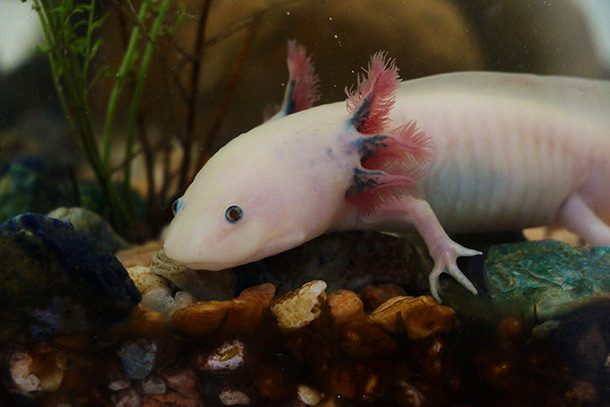 Source: https://www.nationalgeographic.com/animals/amphibians/a/axolotl/, https://www.livescience.com/34513-how-salamanders-regenerate-lost-limbs.html
Source: https://www.nationalgeographic.com/animals/amphibians/a/axolotl/, https://www.livescience.com/34513-how-salamanders-regenerate-lost-limbs.html The Axolotl is practically a real-life Pokemon. With feathery external gills and a tadpole-like dorsel fin, the Axolotl is a weird creature, indeed. Having a condition called Neoteny, the Axolotl retains its larval features throughout its adult life. One might say it’s the animal equivalent of a “man-child.” However, its most impressive ability is perfect regeneration, giving them the power to regrow limbs.
Lists Going Viral Right Now
Photo: 25. Pixabay.com (Public Domain), 24. Wikipedia Commons.com (Public Domain), 23. Paul Shaffner, Starfish 02 (paulshaffner), CC BY 2.0, 22. Wikipedia Commons.com (Public Domain), 21. laszlo-photo, Three-Rowed Sea Cucumber, CC BY 2.0, 20. Peter Southwood, Six gill hagfish Eptatretus hexatrema at the Oakburn DSC09115, CC BY-SA 3.0, 19. Jerry Kirkhart from Los Osos, Calif., Lined Chiton (Tonicella lineata) (2389357812), CC BY 2.0, 18. Klaus, Wild Platypus 4, CC BY-SA 2.0, 17. Gabriel Barathieu, Mother and baby sperm whale, CC BY-SA 2.0, 16. Anker A, Grave S, Alpheus cedrici holotype, dorsal view – ZooKeys-183-001-g003A, CC BY 3.0, 15. Wikipedia Commons.com (Public Domain), 14. Peter Hellberg via flickr. CC BY 2.0, 13. Wikipedia Commons.com (Public Domain), 12. cloudzilla, Hippopotamus in San Diego Zoo, CC BY 2.0, 11. Bernard DUPONT from FRANCE, Sea Slugs (Chromodoris willani) (6085292629), CC BY-SA 2.0, 10. Storm via flickr. CC BY 2.0, 9. Wikipedia Commons.com (Public Domain)
“8. Bjørn Christian Tørrissen, GambianMudskippers, CC BY-SA 4.0, 7. WildSingapore.com (Fair Use: No Free Images Available), 6. Wikipedia Commons.com (Public Domain), 5. Fredlyfish4, Pirate perch, CC BY-SA 3.0, 4. Carnat Joel via flickr. CC BY 2.0, 3. Emőke Dénes, Trichobatrachus robustus 1, CC BY-SA 4.0, 2. Wikipedia Commons.com (Public Domain), 1. Amandasofiarana, Axolotl ambystoma mexicanum anfibio ASAG, CC BY-SA 4.0



























